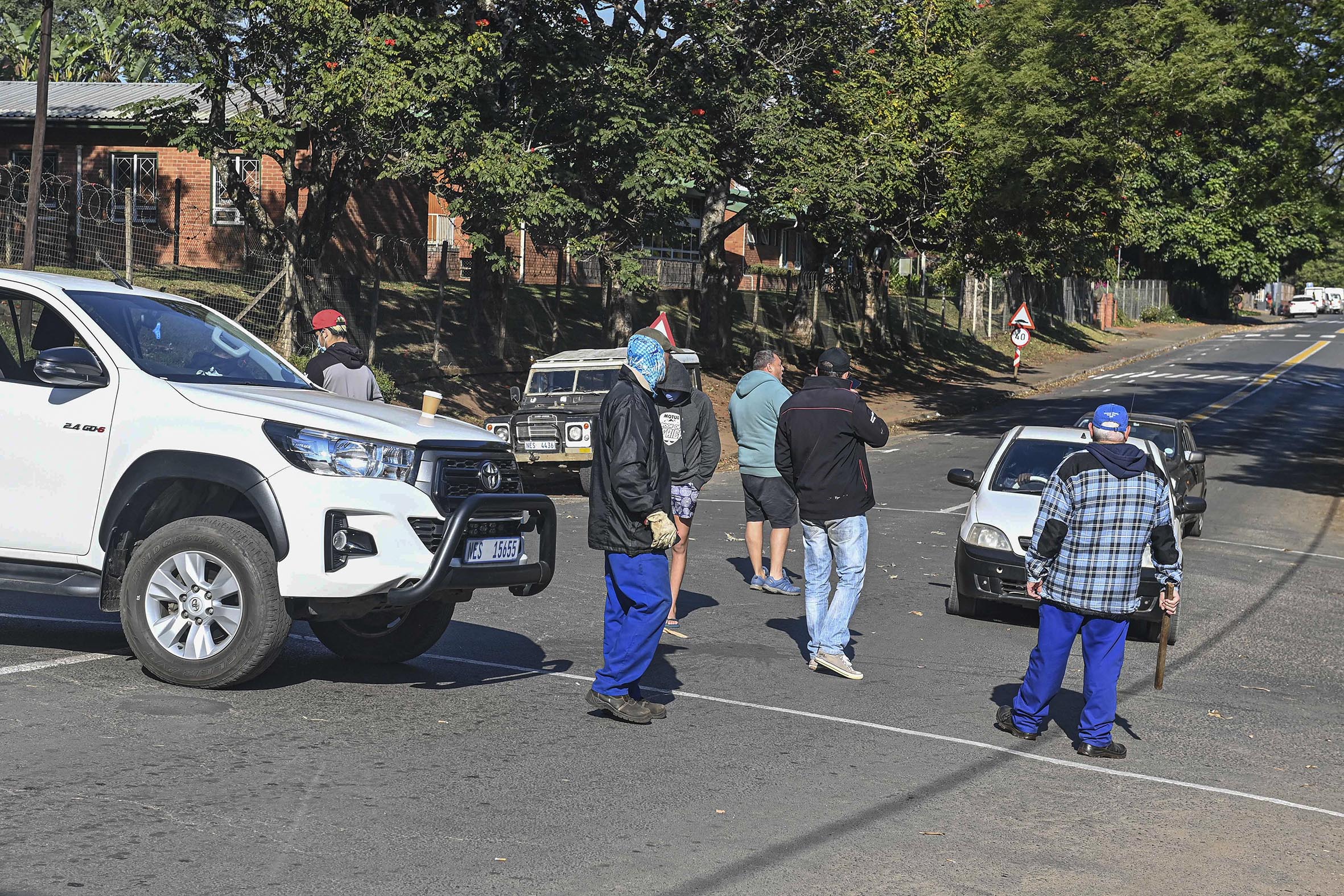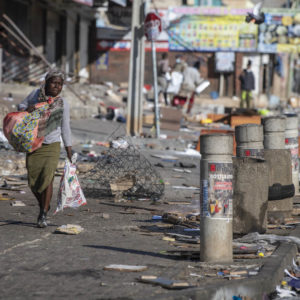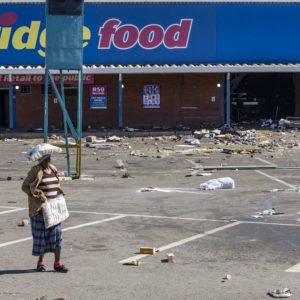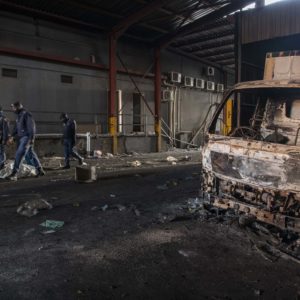KwaZulu-Natal races back to 1949
The past week’s violence and looting – and the potential for an orchestrated race war in the province – have evoked haunting scenes from a bitter and bloody history.
Author:
15 July 2021

On the night of 13 January 1949, my father slept in the sugar-cane fields in Doringkop, on the KwaZulu-Natal North Coast, along with the women and children in his family. He was eight years old.
News had reached the tiny farming hamlet that there had been rioting earlier that day in Durban’s Grey Street area. Shops owned by people of Indian descent had been looted. The violence had started after an altercation between a man of Indian descent and a youngster of Zulu heritage at the Victoria Street Market.
It was the spark that would lead to another two days and nights of wanton destruction of homes and buildings during an “anti-Indian” pogrom defined by murders, rapes and wounds of race and ethnicity that, 27 years after the end of a racist and oppressive system, South Africa has yet to fully heal.
Most of the violence 71 years ago was centred in the multi-ethnic working-class neighbourhood of Cato Manor, or Umkhumbane in isiZulu. The attacks were orchestrated by provocateurs who mobilised the all-male, all-Zulu hostels in the city as well as other local networks. The anaemic police and army presence did not react to the violence happening in front of it. Donald L Horowitz, in The Deadly Ethnic Riot, describes white women celebrating the violence “dancing up the streets” afterwards.

The official count of the devastation was given as 142 deaths and 1 087 injured. One school and one factory were completely destroyed, along with 58 shops and 247 homes, while two factories, 652 shops and 1 285 homes were damaged.
The next night and the night after that, my father’s stepmother and his sisters slept in the homes of their African neighbours. The adult men stood guard over the small farm that my grandfather, whose parents were indentured labourers, had bought in partnership with a cousin after they had saved enough money working at a local sugar mill. My dad and his brothers slept outside among the stalks of sugar cane; for a little boy, the experience was a bewildering mix of fear and adventure.
On the night of 13 July 2021, I helped my mother and father pack small bags with their identity documents, last wills and testaments, chronic medication and a change of clothes. My father also packed a small bag with a winter jersey and treats for their overindulged and overweight dachshund, Toby.
There was no sense of adventure in the air. There was bewilderment. Distress and pain, too. And an unfathomable sense of foreboding that they may have to leave their entire lives behind.
A story of townspeople
My father is 80 years old now. My mother is 77, but she protests that the apartheid government recorded her date of birth incorrectly. They are both retired school principals who are easily recognised by many in Stanger (KwaDukuza), the working-class town where they have built their lives together, and their home in which my sister and I grew up.
Most adults in Stanger have gone through their schools at some point and both are fondly remembered and respected. For this, if I am recognised as my parents’ child, I am usually guaranteed a wider smile and a warm message for them from these locals. Sometimes I even benefit from a discount at one of the many shops in the town that have passed through generations of the same family.
My parents are solid citizens. People who have worked their whole lives to build and uplift their community.

When she was principal of Parkgate Primary School in Ottawa, nearer to Durban, my mother received children from Zwelisha, near Phoenix, and from newly built RDP homes near her school. Those communities had been relocated from shack settlements from Clare Estate and other parts of Durban. On the occasions that I have met her former students, they have spoken – without hyperbole – of my mother as a role model, of her school being an enabling and life-changing experience for them.
Zwelisha is a decades old shack settlement that dates back to the 1990s. Whatever socioeconomic gains have been made in post-apartheid South Africa, precious few have come close to its impoverished edges. It is where, over the past week, 20 people are reported to have been killed in what appears to be increasing racial violence in KwaZulu-Natal. The tension has been orchestrated by provocateurs apparently intent on stoking race-based civil war in the province by targeting specific communities that have deep-running fractures based on inequality and racial mistrust.
My parents believe that ordinary people build communities and a country. They have a strong affinity for equality. In 2010, when the local municipality sought to build a statue of Mohandas Gandhi to commemorate the 150 years since the arrival of the indentured labourers in South Africa, my father petitioned them, on principle, to rather commission a statue celebrating the thousands of indentured labourers themselves. He also pointed out that Gandhi only arrived in South Africa in 1893 as a lawyer, not a bonded labourer. The KwaDukuza local municipality, as is the wont of the ANC generally, preferred the elite individual over ordinary people.
Related article:
My parents care about their community and their country.
Yet on Tuesday night they were preparing, if necessary, to leave their entire lives behind. Photo albums, books, family heirlooms and furniture passed down through generations, birthday cards made by my niece during lockdown… Everything that represents who they are, and what they have survived in a country that has often been oppressive to them, but that they still celebrate as their only one. A country that they have helped build without any thought of recognition or self-enrichment. One that they were watching being destroyed in front of their eyes.
I saw a pain in them that no person should have to bear. I discussed connecting the water hose to an indoor tap with my father, in the instance of our cars in the front yard being petrol-bombed. I swung some sports equipment around, wondering if a childhood cricket bat would be enough to fend off an attack on their home. I tried not to alarm them, but I cried inside.
A looming race war
KwaZulu-Natal appears to be careering towards a full-blown civil war. A war instigated by provocateurs on the ground and on social networking platforms like Twitter, along lines of race and class. But mainly race. Indeed, a mode of making claims in the name of race is being actively used to erase the question of class.
It is a race war to which the government, with its failing intelligence-gathering structures, is only now turning its attention. Part of a wider conflict, whose flames have been gleefully cheered on by people, including former president Jacob Zuma’s daughter Duduzile Zuma-Sambudla and her twin brother Duduzane, on social media. A race war that has been fomented for several years already by the “anti-Indian” demagoguery of people like EFF leader Julius Malema. One that in recent weeks has been stoked by trolls like @nkunz_emnyama (Son_of_the_Azanian_Soil) and @FallIndians (Indians Must Fall) on Twitter.
There has also been incitement on the ground that began during the early stages of the various mobilisations of the past week. Even when the looting was primarily focused on malls and shopping centres, provocateurs – some of them with links to militarised elements in areas like Phoenix – were already engaged in fearmongering about threats to private property among communities and on social networking platforms. Links have been suggested between these provocateurs and the parallel spy structures that Zuma had built up while he was president of South Africa.

Bodies have started appearing, some quite clearly killed by vigilantes in Phoenix. In other instances, the decomposing bodies of the dead have been found at sites of looting, like those at Queen Nandi Drive near Durban.
By 13 July, this race-based fearmongering and incitement were surging. The previous night, a community patrol in Stanger stopped a car trying to access a predominately “Indian” neighbourhood. The car contained people with petrol bombs. The government seemed completely oblivious to this threat. No police were at hand to arrest or interrogate them.
Stark line of division
The N2 highway that runs north from Durban towards Ermelo in Mpumalanga acts as a dividing line between the haves and have-nots along the KwaZulu-Natal North Coast. On the coastal side of the highway are multimillion-rand beachfront real estate and gated “eco-communities” such as Zululami in Salt Rock and Zimbali in Ballito. The latter is where the African political elite have homes alongside whites and people of Indian descent, but the majority of these gated communities are populated by minorities.
On the other side of the N2 are the shack settlements, RDP homes and long-established communities of mainly Black working-class people, with several working-class “Indian” areas as well. Places like Shakaskraal and Tongaat, which go back to the late 1800s.
In many instances, these working-class communities’ jobs are found in the malls and homes across the N2. There have been reports of agent provocateurs infiltrating these communities along the North Coast and inciting them not only to attack the malls and shops, but also the homes of the rich, the whites and the “Indians”.
Related article:
With police presence remaining non-existent since 9 July, many of these affluent communities have sealed off access from the highway and manned checkpoints themselves. Some have been armed, others not. Some have been extremely heavy-handed, others not. African people have been racially profiled at these “checkpoints”, with some denied passage and others asked to produce receipts for the goods in their cars. Some of those who were unwilling to do so had their goods confiscated by the armed vigilantes.
Private security companies have helped to protect neighbourhoods and strengthen the vigilantes. By the morning of 15 July the army presence was still negligible, according to various residents.
The racial and class dynamics inherent in these checkpoints have also contributed to the uneasy race-based tensions reaching boiling point in KwaZulu-Natal. But in some instances, African communities on one side of the highway have negotiated with their employers on the other side to create the impression of group mobilisation and the pretence of a stand-off to keep the provocateurs off their backs, and their job and food security intact.
Left to fend for themselves
The police have disappeared from the streets of Stanger and the neighbouring towns of Shaka’s Rock, Shakaskraal, Ballito, Eshowe, Empangeni and so on. These are towns that, since 9 July, have all been under attack by sinister, external forces that go beyond the politics of hunger that initially drove so many desperate people to steal food.
The security guard at a local mall in Stanger tells me there was intelligence since 11 July about it being attacked. The police were informed but not present. The security company was overwhelmed and the mall was emptied out.
My parents’ home has a view of apartheid’s spatial planning. Across the road from them is an apartheid-era council-built housing estate for working-class people of Indian descent. It sits next to an industrial area with factories and warehouses. On the other side of the industrial area are the mainly African townships of Lindelani and Shakaville.
Related article:
As the looting escalated on 12 July, its changing profile was evident on my parents’ street. First, men, women and children could be seen carrying food back to their homes – unemployment, inequality and desperation leading so many to break the law, and teach their young children this unconscionable lesson.
After lunch, one watched men walking by with alcohol looted from local shops; some dragged crates of beer behind them along the road.
Towards sunset, the clothing and furniture shops were looted and the goods loaded into expensive vans and SUVs. Some people walked by with what they could carry home, mainly clothes, paint and appliances ranging from kettles to televisions. From our vantage point, there were fewer fridges and big-screen televisions going into the township.

Most of the shops being looted on that day were in Stanger’s central business district. Apart from a few franchises, most were family-owned businesses. A sports shop where I remember getting my first pair of football boots decades ago. Shops owned by relatives of people such as former minister Kader Asmal or political activist contemporaries of Chief Albert Luthuli, the Nobel Peace laureate and ANC president who lived in nearby Groutville. People who had sponsored sports tournaments and cultural activities in the town during apartheid, when the white supremacist government sought to inflict a process of reification against us.
By nightfall there would be nothing left in them, or, in some instances, of them – community institutions that had stood for decades.
No one knew where the police were.
The mood changes
The next day saw the mall fall. Again, people used the street on which my parents live to access the council estate and the townships pushing trolleys filled mainly with food, booze, clothes, paint and building materials, television sets and bits of small furniture, like the stools cashiers would have sat on.
The mood had changed, however. There were fewer and fewer women and children on the street. There were more men. More groups of men started to congregate. More ramped up racial vitriol emerging on social media or videos being circulated on WhatsApp.
People of different races were attacking each other. A video of a Pietermaritzburg community setting fire to a shack settlement went viral. Information started filtering in of proposed attacks and counter-attacks on and by communities in Chatsworth, Umlazi, KwaMashu and Phoenix, all working-class townships created by apartheid’s Group Areas Act.
Related article:
My cousin who was part of a group manning a community roadblock nearby reported the situation getting “rowdy” and racialised when cars were stopped. The toxic incitement to race riots continued unabated on social networking platforms. The WhatsApp videos, fake news and hysteria were surging. The national government appeared to be publicly ignorant of what was unfolding in KwaZulu-Natal. The police would not be there to protect people from being attacked in their homes.
I sensed this as much as my parents did. We started to pack a few things.
Related article:
The year 1949 was not far away from our thoughts. I reread Ronnie Govender’s short story, 1949. I plodded fearfully to its end. Dumisane and his family were hiding his landlord, Mr Maniram – and his family – in the house he rented from them as the crowd sought them out:
“Some ran into the main house and after ransacking it, set fire to it. The flames lit the entire area.
‘They’re not in the house. They must be in your house!’
‘Listen, my brother. I don’t like the amaKulas myself. Please don’t go in and frighten my children.’
The crowd stood around hesitantly. Suddenly a young man broke from the crowd and dashed into the house. Within seconds he was shouting, ‘He’s lying. They are hiding under the beds!’
All mercy deserted them.
It deserted the souls of fathers, mothers, sons and daughters, giving way to the savagery that lurks eternally in the human heart. Out of the time warp of primeval hate flew the spear. It shot through Dumi’s chest. There was no pity, no reason in the hearts of these malleable souls, held captive by minds more savage in their cunning – the cunning on which empires have been built.”





